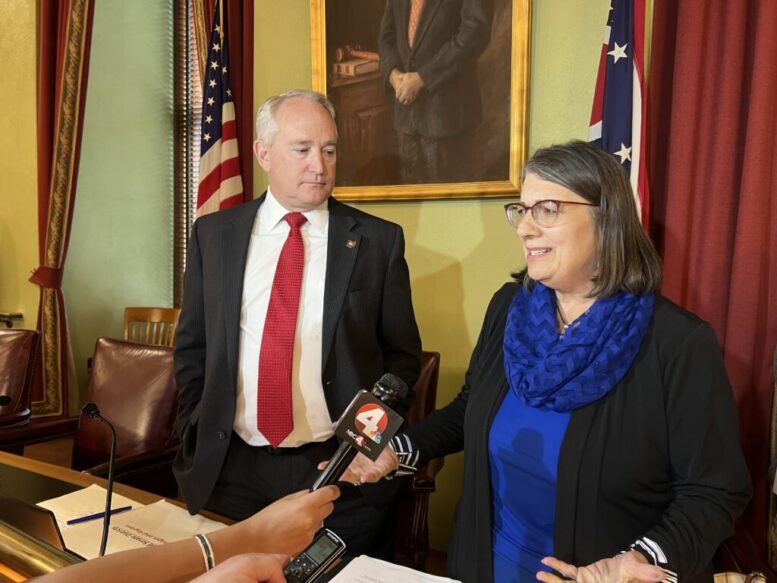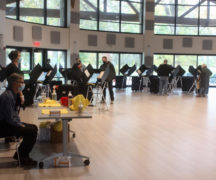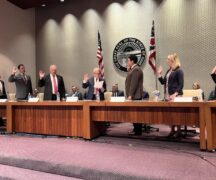BY SUSAN TEBBEN
The Ohio Redistricting Commission reached bipartisan agreement as it passed new Statehouse maps late Tuesday night after a few more hours of public comment, and then negotiation behind closed doors.
The maps show a Republican-to-Democratic advantage of 61 to 38 in the Ohio House, with eight Democratic toss-up seats and three GOP toss-ups. In the Ohio Senate, the maps show a 23 to 10 Republican advantage, with three Republican toss-up seats and one Democratic toss-up seat.
The maps show a Republican advantage of 61-38 in the Ohio House and a 23-10 advantage in the Ohio Senate.
The commission held a fourth meeting for public testimony on Tuesday morning, with dozens more Ohioans submitting public comment the day after a doubleheader in Newbury on Monday.
As the Tuesday meeting opened, Republican Auditor of State and commission co-chair Keith Faber said negotiations went on after the meetings on Monday and were actively happening even as public testimony happened Tuesday.
“This map is the result of an awful lot of hours of discussion, consideration, negotiation, mediation and more discussion,” Faber said on Tuesday night.
The public wasn’t able to review the maps that were adopted Tuesday, as the product, amended from last week’s GOP proposal, was introduced at about 10 p.m. that night, something House Minority Leader Allison Russo mentioned in prefacing her “yes” vote.
“To me, it’s not a vote because I think that these maps are fair, or that this process worked the way that it was supposed to,” Russo said. “My vote is simply to take this process out of the hands of this commission.”

Senate Minority Leader and commission co-chair Nickie Antonio supported the idea that the redistricting process “does not belong in our hands,” but praised the members of the public whose influence was not lost on her.
“We worked hard to find a compromise, and it’s illustrated by the amended maps that we have before us today,” Antonio said.
She said the agreement is “more fair” than the proposal introduced last week, and “does provide a pathway” for an increased number of Democratic Senate seats, a priority for her.
“We think there will be more competitive races, we hope there will be more competitive races,” said Antonio, who also pushed for further changes to the redistricting process.

Maps and process criticized by coalition working for fair districts
The Ohio advocate coalitions Equal Districts and Fair Districts issued a joint statement Tuesday night criticizing the maps, calling the agreement, “the latest political power-grab by both the Republican and Democratic members of the commission.”
“Politicians are getting in our way,” said Molly Shack and Prentiss Haney, Co-Executive Directors of the Ohio Organizing Collaborative speaking on behalf of Equal Districts. “It has become obvious that we cannot trust politicians to deliver the fair maps Ohioans deserve. We must remove politicians from the process and give power back to the people. We look forward to making that change by amending the Ohio Constitution in November 2024.”
The coalitions said the maps “shockingly garnered the support of the two lone Democratic Commission members.”
“This corrupt, undemocratic process has resulted in rigged maps that help politicians and their friends get re-elected at the expense of Ohio families and communities,” said Catherine Turcer, Executive Director of Common Cause Ohio, speaking on behalf of Fair Districts. “We are working together on an amendment to ban politicians from map drawing so that Ohio voters get the impartial districts they fundamentally deserve, and lawmakers will be responsive to the people rather than mega-donors and lobbyists.”
Public input earlier Tuesday
Public testimony on Tuesday touched on certain parts of the maps proposed last week as part of a “working document,” which were accused of being partisan gerrymanders, but also shamed the GOP for a lack of transparency.
“I’d be delighted to see maps that are equitable,” said Beavercreek resident Daniel Hogg. “Prove me wrong, please. I want you to prove me wrong. Draw fair districts.”
Mike Halaiko asked the ORC to refocus on the task they were give more than two years ago, when the process began, and even before then when a ballot initiative reformed redistricting methods in the state.
“What the people of Ohio have asked for several times at the ballot box, in the last eight years is simple and direct: end all gerrymandering to favor any political party,” Halaiko told the commission.
State Sen. Paula Hicks-Hudson, D-Toledo, attended the meeting with a report from an informal town hall held in Lucas County, where she said the main theme was a feeling of disconnectedness from the process and even their own representatives.
“Unfortunately, last night many of the comments were that they felt that their voices were not being part of this conversation, and not being heard.”
What comes next?
The maps still could be challenged via the Ohio Supreme Court, as the last five versions have been.
All five of those maps were rejected for undue partisan favoritism, leading to the sixth effort in the last few weeks, but that involved a swing vote from conservative Chief Justice Maureen O’Connor.
O’Connor left the state’s high court after being age-limited, and is now part of an effort to reform the redistricting process yet again by creating a citizen-led redistricting commission and removing the politicians from the process.
But her successor, Chief Justice Sharon Kennedy, was a supporter of previous maps, writing in dissent of the rejections in the past, which could spell an easier journey in a court challenge.
An “if-needed” meeting of the commission is scheduled for Friday to allow for reconciliations between the original proposed maps and those adopted on Tuesday.
Faber and state Sen. Rob McColley, R-Napoleon, said they don’t expect the meeting to be needed, but scheduled it in case staff need more time to adjust maps and accommodate changes.




